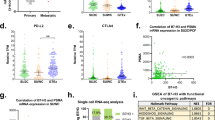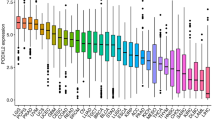Abstract
Background:
B7-H3 (CD276), part of the B7 superfamily of immune checkpoint molecules, has been shown to have an immunomodulatory role. Its regulation, receptor and mechanism of action remain unclear. B7-H3 protein expression correlates with prostate cancer outcomes, and humanized monoclonal antibodies (that is, enoblituzumab) are currently being investigated for therapeutic use. Here we used genomic expression data to examine the relationship between B7-H3 mRNA expression and prostate cancer.
Methods:
Prostatectomy tissue from 2781 patients were profiled using the Affymetrix HuEx 1.0 ST microarray. Pairwise comparisons were used to identify significant associations between B7-H3 expression and clinicopathologic variables, and survival analyses were used to evaluate the prognostic significance of B7-H3. Pearson’s correlation analyses were performed to assess the relationship of B7-H3 expression with molecular subtypes and individual transcripts. Androgen receptor (AR) occupancy at the B7-H3 locus was determined using chromatin immunoprecipitation (ChIP), and androgen-dependent expression changes in B7-H3 was evaluated by quantitative reverse transcription PCR in LNCaP cell lines. Oncomine was queried to evaluate B7-H3 expression in metastatic disease.
Results:
B7-H3 mRNA expression was positively associated with higher Gleason score (P<0.001), tumor stage (P<0.001), and castrate resistant metastatic disease (P<0.0001). High B7-H3 expression correlated with the development of metastasis and prostate cancer specific mortality, but this was not significant on multi-variable analysis. B7-H3 expression correlated with ERG-positive disease (r=0.99) and AR expression (r=0.36). ChIP revealed an AR-binding site upstream of B7-H3, and the presence of androgens decreased B7-H3 expression in LNCaP suggesting potential direct AR regulation. Gene set enrichment analysis demonstrated an association of B7-H3 with androgen signaling as well as immune regulatory pathways.
Conclusions:
Higher B7-H3 expression correlates with Gleason grade, prostate cancer stage and poor oncologic outcomes in prostatectomy cohorts. B7-H3 expression appears to be related to androgen signaling as well as the immune reactome.
This is a preview of subscription content, access via your institution
Access options
Subscribe to this journal
Receive 4 print issues and online access
$259.00 per year
only $64.75 per issue
Buy this article
- Purchase on Springer Link
- Instant access to full article PDF
Prices may be subject to local taxes which are calculated during checkout






Similar content being viewed by others
References
Thompson RH, Kwon ED, Allison JP . Inhibitors of B7-CD28 costimulation in urologic malignancies. Immunotherapy 2009; 1: 129–139.
Topalian SL, Hodi FS, Brahmer JR, Gettinger SN, Smith DC, McDermott DF et al. Safety, activity, and immune correlates of anti-PD-1 antibody in cancer. N Engl J Med 2012; 366: 2443–2454.
Chapoval AI, Ni J, Lau JS, Wilcox RA, Flies DB, Liu D et al. B7-H3: a costimulatory molecule for T cell activation and IFN-gamma production. Nat Immunol 2001; 2: 269–274.
Luo L, Zhu G, Xu H, Yao S, Zhou G, Zhu Y et al. B7-H3 Promotes pathogenesis of autoimmune disease and inflammation by regulating the activity of different T cell subsets. PLoS ONE 2015; 10: e0130126.
Kreymborg K, Haak S, Murali R, Wei J, Waitz R, Gasteiger G et al. Ablation of B7-H3 but not B7-H4 results in highly increased tumor burden in a murine model of spontaneous prostate cancer. Cancer Immunol Res 2015; 3: 849–854.
Sun X, Vale M, Leung E, Kanwar JR, Gupta R, Krissansen GW . Mouse B7-H3 induces antitumor immunity. Gene Ther 2003; 10: 1728–1734.
Luo L, Chapoval AI, Flies DB, Zhu G, Hirano F, Wang S et al. B7-H3 enhances tumor immunity in vivo by costimulating rapid clonal expansion of antigen-specific CD8+ cytolytic T cells. J Immunol 2004; 173: 5445–5450.
Roth TJ, Sheinin Y, Lohse CM, Kuntz SM, Frigola X, Inman BA et al. B7-H3 ligand expression by prostate cancer: a novel marker of prognosis and potential target for therapy. Cancer Res 2007; 67: 7893–7900.
Zang X, Thompson RH, Al-Ahmadie HA, Serio AM, Reuter VE, Eastham JA et al. B7-H3 and B7x are highly expressed in human prostate cancer and associated with disease spread and poor outcome. Proc Natl Acad Sci USA 2007; 104: 19458–19463.
Parker AS, Heckman MG, Sheinin Y, Wu KJ, Hilton TW, Diehl NN et al. Evaluation of B7-H3 expression as a biomarker of biochemical recurrence after salvage radiation therapy for recurrent prostate cancer. Int J Radiat Oncol Biol Phys 2011; 79: 1343–1349.
Chavin G, Sheinin Y, Crispen PL, Boorjian SA, Roth TJ, Rangel L et al. Expression of immunosuppresive B7-H3 ligand by hormone-treated prostate cancer tumors and metastases. Clin Cancer Res 2009; 15: 2174–2180.
Yamoah K, Johnson MH, Choeurng V, Faisal FA, Yousefi K, Haddad Z et al. Novel biomarker signature that may predict aggressive disease in african american men with prostate cancer. J Clin Oncol 2015; 33: 2789–2796.
Ross AE, Johnson MH, Yousefi K, Davicioni E, Netto GJ, Marchionni L et al. Tissue-based genomics augments post-prostatectomy risk stratification in a natural history cohort of intermediate- and high-risk men. Eur Urol 2016; 69: 157–165.
Erho N, Crisan A, Vergara IA, Mitra AP, Ghadessi M, Buerki C et al. Discovery and validation of a prostate cancer genomic classifier that predicts early metastasis following radical prostatectomy. PLoS ONE 2013; 8: e66855.
Piccolo SR, Sun Y, Campbell JD, Lenburg ME, Bild AH, Johnson WE . A single-sample microarray normalization method to facilitate personalized-medicine workflows. Genomics 2012; 100: 337–344.
Yu J, Yu J, Mani RS, Cao Q, Brenner CJ, Cao X et al. An integrated network of androgen receptor, polycomb, and TMPRSS2-ERG gene fusions in prostate cancer progression. Cancer Cell 2010; 17: 443–454.
Robinson JT, Thorvaldsdottir H, Winckler W, Guttman M, Lander ES, Getz G et al. Integrative genomics viewer. Nat Biotechnol 2011; 29: 24–26.
Haffner MC, Aryee MJ, Toubaji A, Esopi DM, Albadine R, Gurel B et al. Androgen-induced TOP2B-mediated double-strand breaks and prostate cancer gene rearrangements. Nat Genet 2010; 42: 668–675.
Therneau TM, Li H . Computing the Cox model for case cohort designs. Lifetime Data Anal 1999; 5: 99–112.
Tomlins SA, Alshalalfa M, Davicioni E, Erho N, Yousefi K, Zhao S et al. Characterization of 1577 primary prostate cancers reveals novel biological and clinicopathologic insights into molecular subtypes. Eur Urol 2015; 68: 555–567.
Dennis G Jr, Sherman BT, Hosack DA, Yang J, Gao W, Lane HC et al. DAVID: Database for Annotation, Visualization, and Integrated Discovery. Genome Biol 2003; 4: P3.
Agell L, Hernandez S, Nonell L, Lorenzo M, Puigdecanet E, de Muga S et al. A 12-gene expression signature is associated with aggressive histological in prostate cancer: SEC14L1 and TCEB1 genes are potential markers of progression. Am J Pathol 2012; 181: 1585–1594.
Larkin J, Chiarion-Sileni V, Gonzalez R, Grob JJ, Cowey CL, Lao CD et al. Combined nivolumab and ipilimumab or monotherapy in untreated melanoma. N Engl J Med 2015; 373: 23–34.
Powles T, Eder JP, Fine GD, Braiteh FS, Loriot Y, Cruz C et al. MPDL3280A (anti-PD-L1) treatment leads to clinical activity in metastatic bladder cancer. Nature 2014; 515: 558–562.
Garon EB, Rizvi NA, Hui R, Leighl N, Balmanoukian AS, Eder JP et al. Pembrolizumab for the treatment of non-small-cell lung cancer. N Engl J Med 2015; 372: 2018–2028.
Kantoff PW, Higano CS, Shore ND, Berger ER, Small EJ, Penson DF et al. Sipuleucel-T immunotherapy for castration-resistant prostate cancer. N Engl J Med 2010; 363: 411–422.
Kwon ED, Drake CG, Scher HI, Fizazi K, Bossi A, van den Eertwegh AJ et al. Ipilimumab versus placebo after radiotherapy in patients with metastatic castration-resistant prostate cancer that had progressed after docetaxel chemotherapy (CA184-043): a multicentre, randomised, double-blind, phase 3 trial. Lancet Oncol 2014; 15: 700–712.
Powderly J, Cole G, Flaherty K, Szmulewitz RZ, Ribas A, Weber J et al. Interim results of an ongoing Phase I, dose escalation study of MGA271 (Fc-optimized humanized anti-B7-H3 monoclonal antiody) in patients with refractory B7-H3-expressing neoplamss whose vasculature expresses B7-H3. Journal for Immunotherapy of Cancer. 2015; 3 (Suppl 2).
Lupu CM, Eisenbach C, Lupu AD, Kuefner MA, Hoyler B, Stremmel W et al. Adenoviral B7-H3 therapy induces tumor specific immune responses and reduces secondary metastasis in a murine model of colon cancer. Oncol Rep 2007; 18: 745–748.
Hashiguchi M, Kobori H, Ritprajak P, Kamimura Y, Kozono H, Azuma M . Triggering receptor expressed on myeloid cell-like transcript 2 (TLT-2) is a counter-receptor for B7-H3 and enhances T cell responses. Proc Natl Acad Sci USA 2008; 105: 10495–10500.
Wu CP, Jiang JT, Tan M, Zhu YB, Ji M, Xu KF et al. Relationship between co-stimulatory molecule B7-H3 expression and gastric carcinoma histology and prognosis. World J Gastroenterol 2006; 12: 457–459.
Loos M, Hedderich DM, Ottenhausen M, Giese NA, Laschinger M, Esposito I et al. Expression of the costimulatory molecule B7-H3 is associated with prolonged survival in human pancreatic cancer. BMC Cancer 2009; 9: 463.
Crispen PL, Sheinin Y, Roth TJ, Lohse CM, Kuntz SM, Frigola X et al. Tumor cell and tumor vasculature expression of B7-H3 predict survival in clear cell renal cell carcinoma. Clin Cancer Res 2008; 14: 5150–5157.
Chaudhry A, Rudensky AY . Control of inflammation by integration of environmental cues by regulatory T cells. J Clin Invest 2013; 123: 939–944.
Galon J, Costes A, Sanchez-Cabo F, Kirilovsky A, Mlecnik B, Lagorce-Pages C et al. Type, density, and location of immune cells within human colorectal tumors predict clinical outcome. Science 2006; 313: 1960–1964.
Acknowledgements
AER is supported by a DOD PRTA W81XWH-13-1-0445. AER, SGZ, JLB and MCH are supported by PCF Young Investigator grants.
Author information
Authors and Affiliations
Corresponding author
Ethics declarations
Competing interests
The authors declare no conflict of interest.
Additional information
Supplementary Information accompanies the paper on the Prostate Cancer and Prostatic Diseases website
Supplementary information
Rights and permissions
About this article
Cite this article
Benzon, B., Zhao, S., Haffner, M. et al. Correlation of B7-H3 with androgen receptor, immune pathways and poor outcome in prostate cancer: an expression-based analysis. Prostate Cancer Prostatic Dis 20, 28–35 (2017). https://doi.org/10.1038/pcan.2016.49
Received:
Revised:
Accepted:
Published:
Issue Date:
DOI: https://doi.org/10.1038/pcan.2016.49
This article is cited by
-
Survival and clinicopathological significance of B7-H3 in bladder cancer: a systematic review and meta-analysis
BMC Urology (2024)
-
Enhancing surgical outcomes: accurate identification and removal of prostate cancer with B7-H3-targeted NIR-II molecular imaging
European Journal of Nuclear Medicine and Molecular Imaging (2024)
-
Clinical significance of B7-H3 expression in circulating CD4+CD25high T cells, CD14+ monocytes, and plasma for the progression of HIV infection
BMC Infectious Diseases (2023)
-
Membrane tension-mediated stiff and soft tumor subtypes closely associated with prognosis for prostate cancer patients
European Journal of Medical Research (2023)
-
mTORC1 upregulates B7-H3/CD276 to inhibit antitumor T cells and drive tumor immune evasion
Nature Communications (2023)



